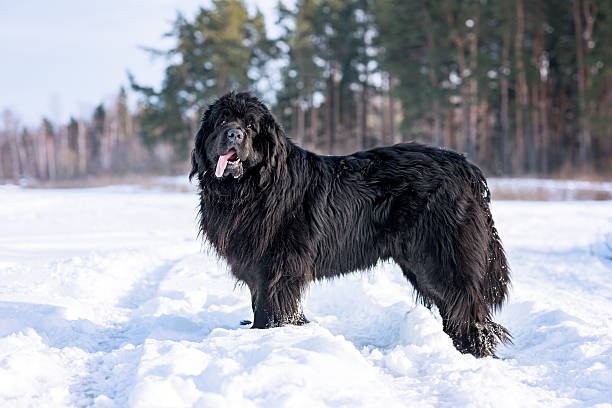The Majestic Newfoundland Dog: A Gentle Giant
The Newfoundland, often referred to as a “Newfie,” is a breed that captures the hearts of dog lovers with its imposing size, gentle demeanor, and distinctive appearance. Known for their strength, intelligence, and swimming prowess, these dogs have a rich history and have endeared themselves to families worldwide. In this exploration of the Newfoundland dog, we’ll delve into their origins, unique characteristics, temperament, and the joys of having these gentle giants as companions.
Origins and History
The Newfoundland dog originated in Newfoundland, Canada, where it was developed to assist fishermen in hauling nets and rescuing individuals at risk of drowning. The breed’s exact ancestry is not definitively documented, but it is believed to have been influenced by the Great Pyrenees, Portuguese Water Dog, and other working breeds. Their webbed feet, water-resistant double coat, and natural swimming ability are well-suited to the harsh maritime environment of their place of origin.
Newfoundlands gained recognition in the 18th century for their exceptional water rescue skills. Their large, strong bodies and thick, water-resistant fur made them invaluable assets to fishing communities. Over time, they found their way to England, where their impressive qualities were further acknowledged, leading to the establishment of the breed standard.
Physical Characteristics
Newfoundlands are large dogs, known for their robust build and powerful stature. Adult males typically weigh between 130 to 150 pounds, while females weigh slightly less, ranging from 100 to 120 pounds. Their size, coupled with a thick, water-resistant double coat that can be black, brown, gray, or Landseer (white with black markings), contributes to their majestic appearance.
One of the most distinctive features of the Newfoundland is its webbed feet, which aid in swimming. Their broad, strong head is accentuated by expressive, dark eyes that convey a gentle and intelligent demeanor. Ears are relatively small, and their tail is long and plume-like. The overall impression is one of strength, balance, and grace.
Temperament and Personality
Despite their imposing size, Newfoundlands are renowned for their gentle and sweet nature. They are often described as “gentle giants” and are known for their calm and patient disposition. This breed is particularly good with children, making them an excellent choice for families. Their protective instincts, combined with a friendly and sociable nature, create a loyal and loving companion.
Newfoundlands are highly intelligent and trainable, although they may display a bit of stubbornness at times. Positive reinforcement methods and consistent training are essential to bring out their best qualities. Due to their working heritage, they thrive on being part of family activities and appreciate having a job to do, whether it’s fetching, pulling a cart, or participating in water rescue drills.
Water Rescue Abilities
The Newfoundland’s natural affinity for water and swimming abilities are legendary. Their webbed feet, strong muscles, and buoyant double coat make them superb swimmers. Historically, they were employed by fishermen to assist in hauling nets and rescuing people at risk of drowning. Their innate swimming talents have also earned them a reputation as water rescue dogs.
In modern times, Newfoundlands continue to excel in water-related activities and competitions. They are often trained in water rescue scenarios and are known to instinctively assist anyone in distress in the water. Their remarkable abilities in this regard have saved many lives over the years, further highlighting the breed’s dedication and utility.
Exercise and Care
While Newfoundlands are generally laid-back and gentle, they do require regular exercise to maintain good health and prevent obesity. Daily walks, playtime, and mental stimulation are important for their well-being. Despite their love for water, care should be taken to monitor them during hot weather, as their thick coat can make them susceptible to overheating.
Grooming is another aspect of Newfoundland care that requires attention. Their double coat, which sheds seasonally, should be brushed regularly to prevent matting and reduce shedding. Additionally, attention should be given to their ears, teeth, and nails to ensure overall health and hygiene.
The Joy of Newfoundland Companionship
Owning a Newfoundland can be a truly rewarding experience. Their affectionate nature, loyalty, and adaptability make them wonderful family pets. While their size may seem intimidating, their gentle temperament and love for human companionship quickly dispel any fears. Newfoundlands often form strong bonds with their families and are known to be particularly good with children.
Their calm and composed demeanor also makes them excellent therapy dogs, providing comfort and companionship to those in need. Their large size and warm fur make them ideal cuddle buddies, and their watchful yet gentle presence can provide a sense of security to their human companions.
Conclusion
In conclusion, the Newfoundland dog is a magnificent breed that combines strength, intelligence, and a gentle disposition. Their historical roles as working dogs in the maritime communities of Newfoundland, coupled with their modern-day reputation as devoted family companions, highlight their versatility and adaptability.
Whether assisting fishermen, excelling in water rescue, or simply being a loyal and affectionate member of the family, the Newfoundland continues to capture the hearts of dog enthusiasts around the world. As with any breed, responsible ownership, proper training, and attention to their specific needs contribute to a harmonious and fulfilling relationship with these gentle giants.





[…] it’s true that some dogs may have a natural inclination towards a more relaxed lifestyle, it’s crucial to meet their basic needs for physical and […]